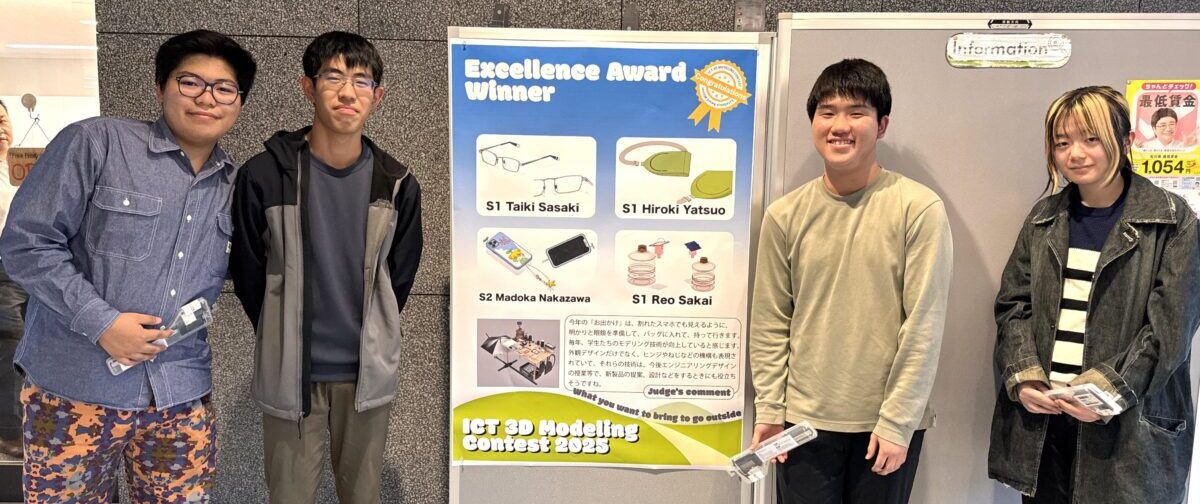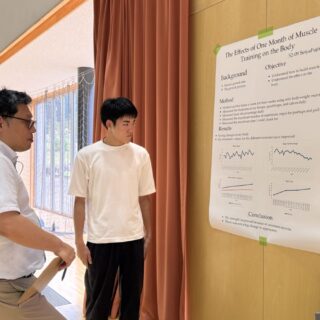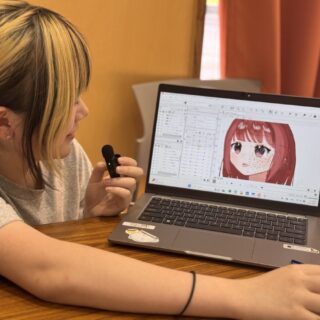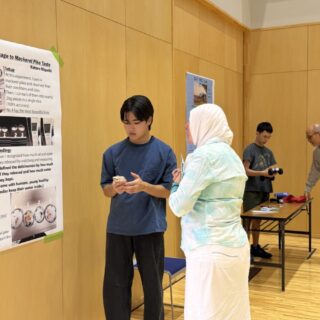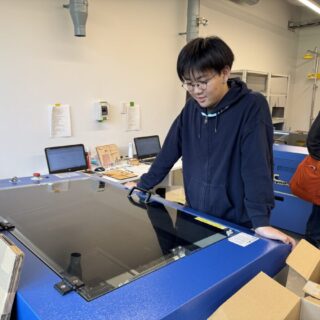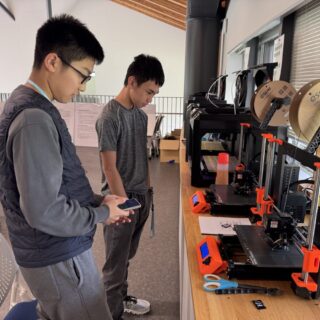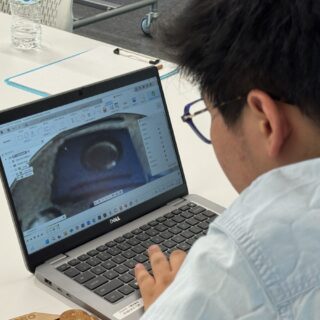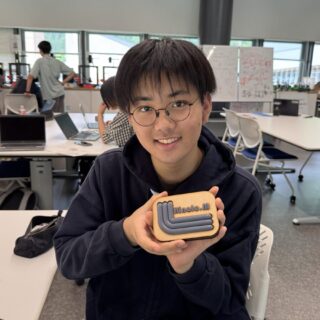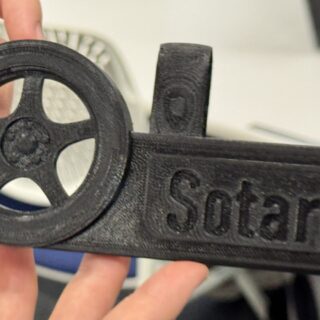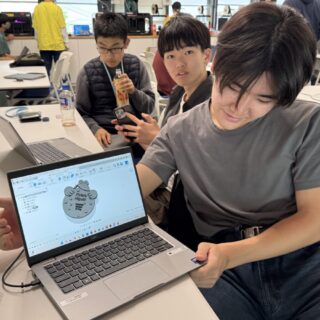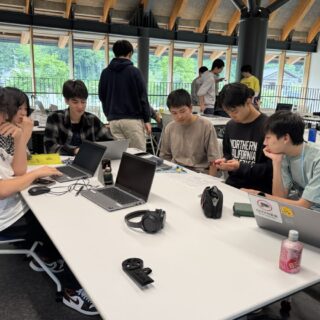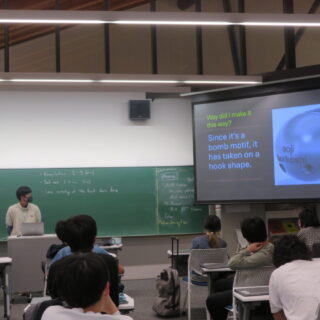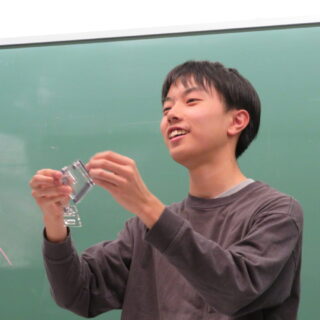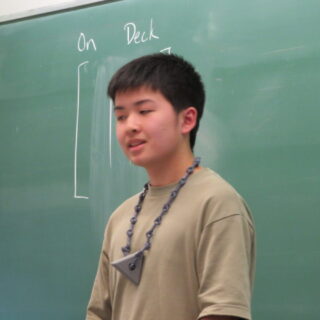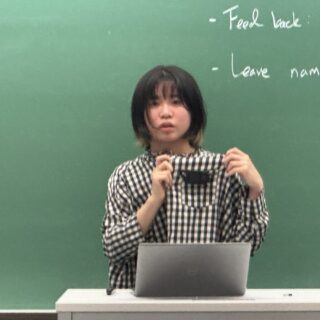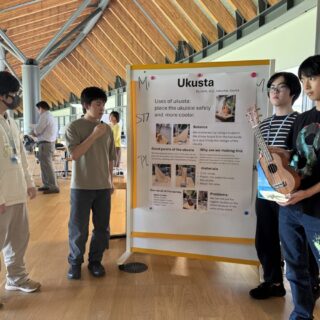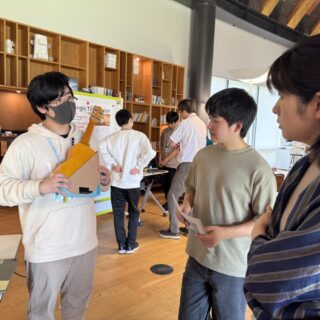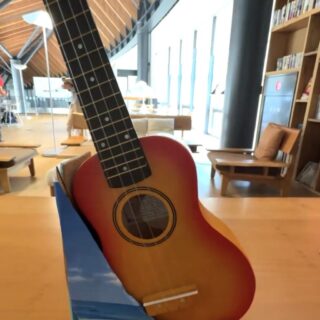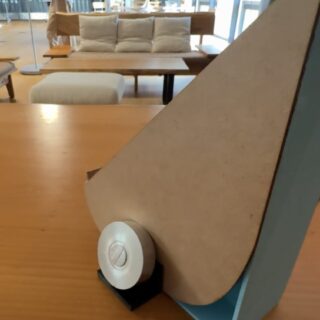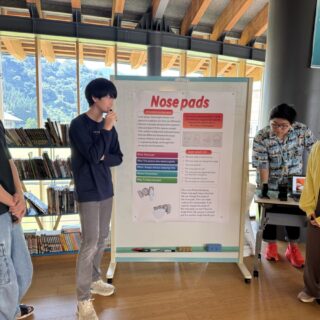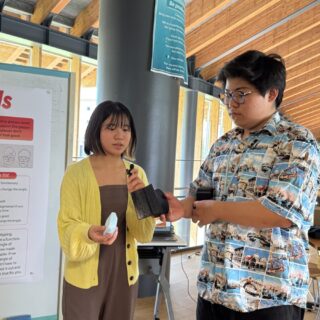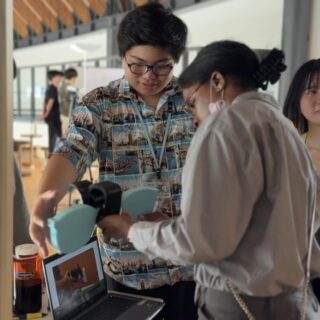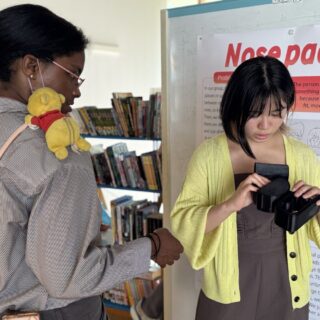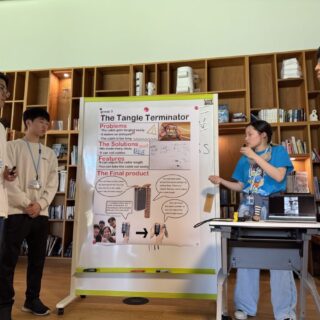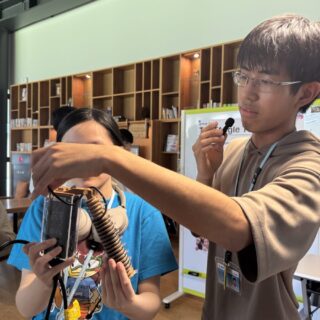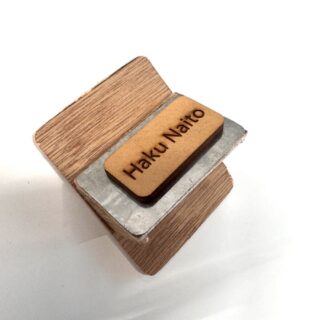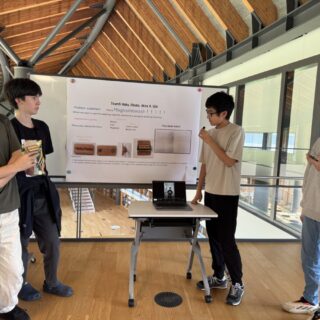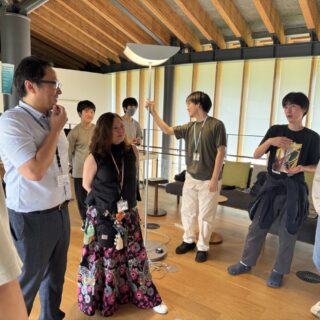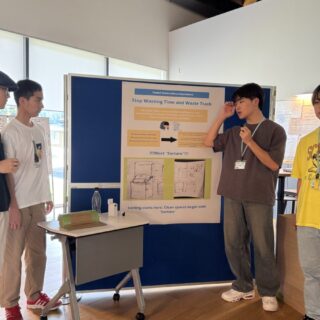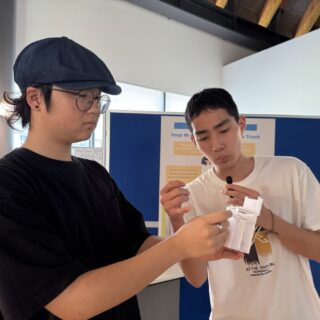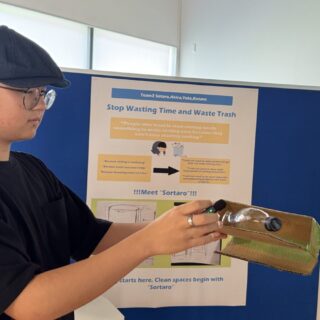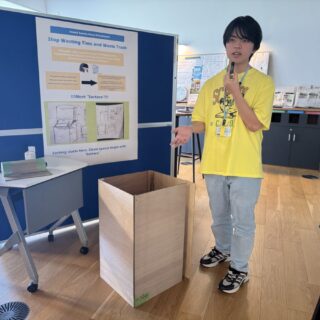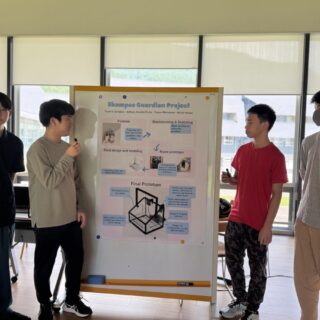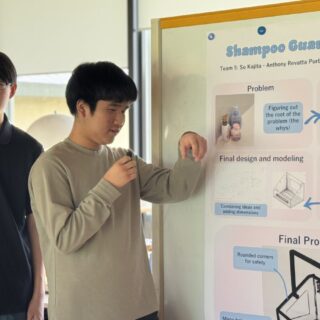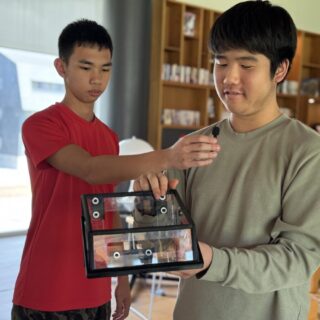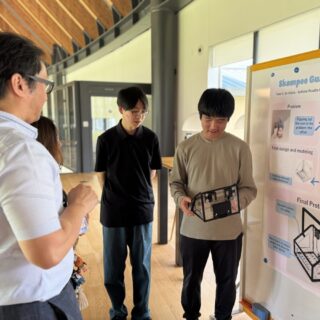ED Education
エンジニアリングデザイン教育
 デザイン&ファブリケーション部顧問の林 道大です。本年度も夏季休暇中の課題として、3DCADモデリングに学生たちが取り組みました。今年のテーマは「お出かけに持って行くもの」で、1・2年生の学生たちから30点以上の作品が提出されました。提出された作品はさまざまなジャンルのものが網羅されており、全部を持ってお出かけすれば、楽しく、便利な遠足となりそうです。提出された全てを審査員たちで審査を行い、優秀賞4作品を選出しました。
デザイン&ファブリケーション部顧問の林 道大です。本年度も夏季休暇中の課題として、3DCADモデリングに学生たちが取り組みました。今年のテーマは「お出かけに持って行くもの」で、1・2年生の学生たちから30点以上の作品が提出されました。提出された作品はさまざまなジャンルのものが網羅されており、全部を持ってお出かけすれば、楽しく、便利な遠足となりそうです。提出された全てを審査員たちで審査を行い、優秀賞4作品を選出しました。
優秀賞となった作品について、それぞれ解説していきます。
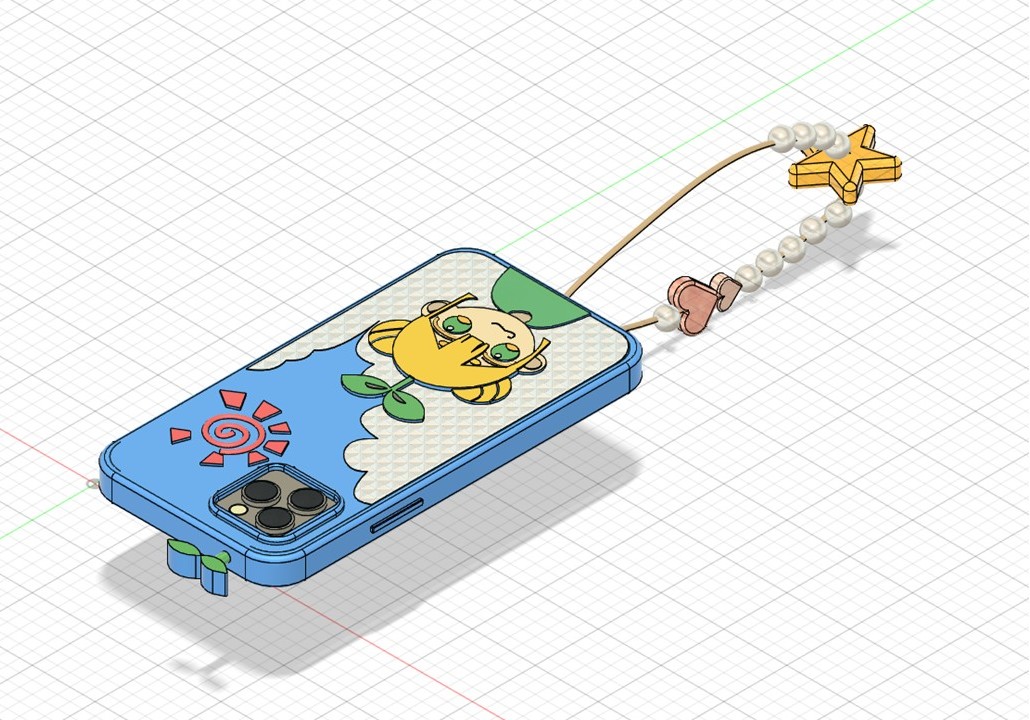 まず、2年生中澤 円香さんの作品「わたしのスマホ」です。幾何学的な形状としてはシンプルなスマホをモデリングしていますが、かなりデコっています。円弧や直線の組み合わせで、かわいらしいキャラクターをうまく再現しています。ストラップのビーズの表現も上手です。輝く太陽もCADでは難しいと思われる手書き風にモデリングされています。画面が割れているところまで表現しているのも、手が込んでいました。
まず、2年生中澤 円香さんの作品「わたしのスマホ」です。幾何学的な形状としてはシンプルなスマホをモデリングしていますが、かなりデコっています。円弧や直線の組み合わせで、かわいらしいキャラクターをうまく再現しています。ストラップのビーズの表現も上手です。輝く太陽もCADでは難しいと思われる手書き風にモデリングされています。画面が割れているところまで表現しているのも、手が込んでいました。
2年生中澤さんコメント
制作時間:1日少しずつ作業して、1週間くらいかかりました。
こだわり:カメラレンズの周辺やキャラクターの表情など細かいところまでモデリングしました。やっぱり、割れたスクリーンが一番のポイントです。
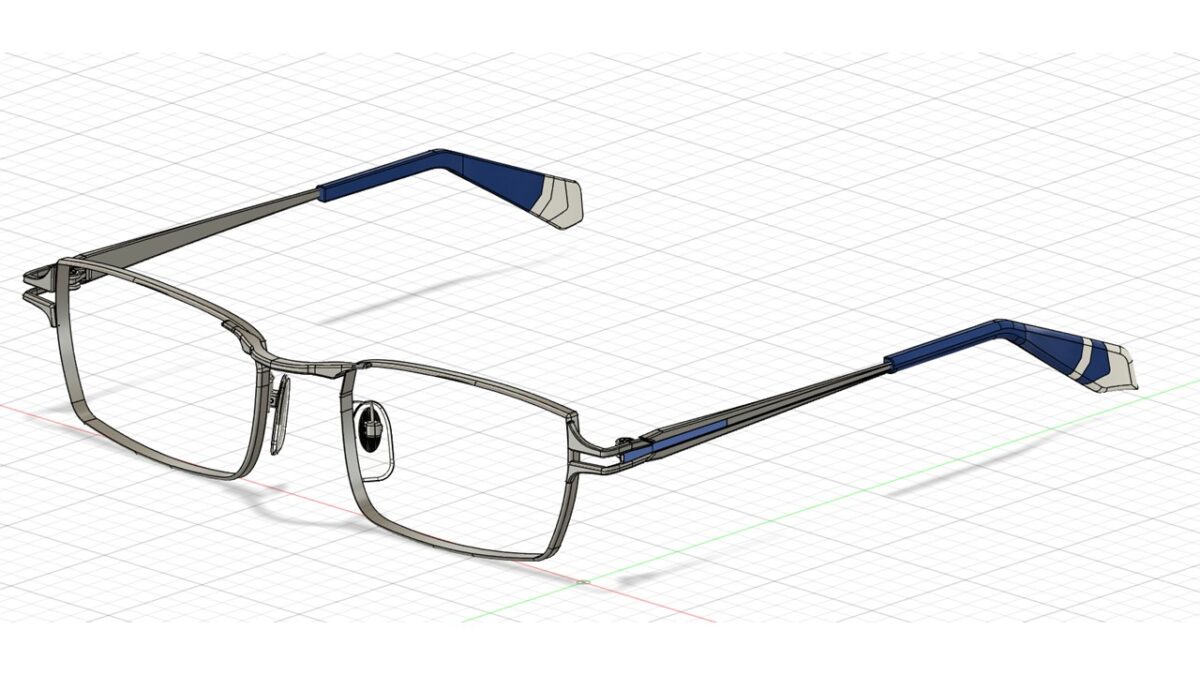
次は、1年生笹木 大暉さんの作品「わたしの眼鏡」です。とてもリアルにモデリングされた眼鏡です。眼鏡屋さんのカタログに載っていそうです。全体の形状だけでなく、リム、ブリッジ、智、鼻パッド、丁番、テンプルまでしっかりと再現されています。複雑な曲面で構成されているパーツも、とても丁寧に形状が再現されています。この眼鏡をかけたら、少し賢くなるような気がするのは、制作者の思いが作品に反映されているのでしょうか。
1年生 笹木さんコメント
制作時間:6時間くらいだと思います。
こだわり:自分が使っている眼鏡を良く観察しました。特にレンズをはめるリムの立体感に注意してモデリングしました。
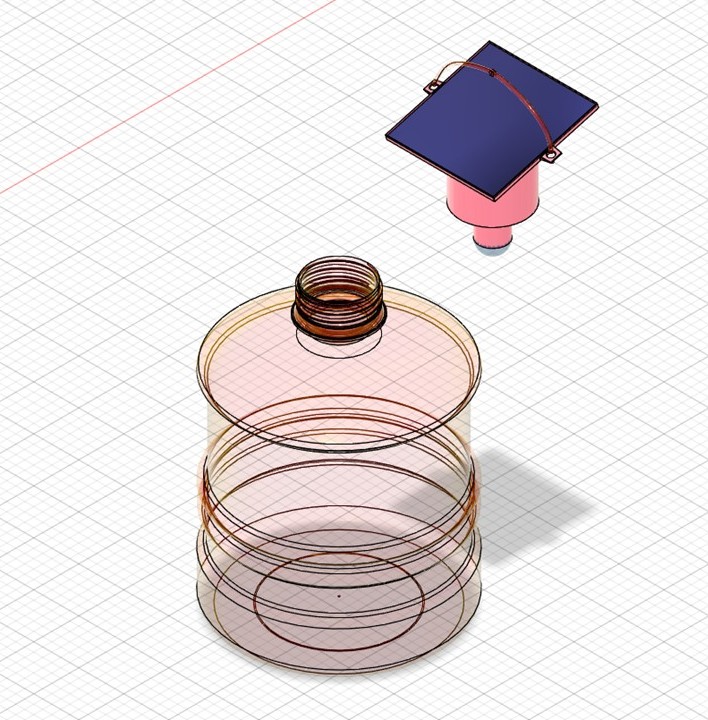
次は、1年生 坂井 麗央さんの作品「わたしのランタン」です。全体の形状をバランス良くモデリングしています。灯したり、消したりする機構や、燃料を入れる部分、ネジ締めする蓋の部分も、その機能が説明できるように丁寧に作成しています。薄暗いテントの中で炎がゆらゆらと揺らめく様子をCGで再現したら、とても美しい動画となるのではないでしょうか。CG(コンピュータグラフィックス)コンテストでも上位入賞できると思います。
1年生 坂井さんコメント
制作時間:3時間くらいの作業を2、3日続けました。
こだわり:テクスチャの設定や蓋部分のねじ形状にこだわりました。蓋部分は3Dプリントしたら実際の蓋として使えるはずです。
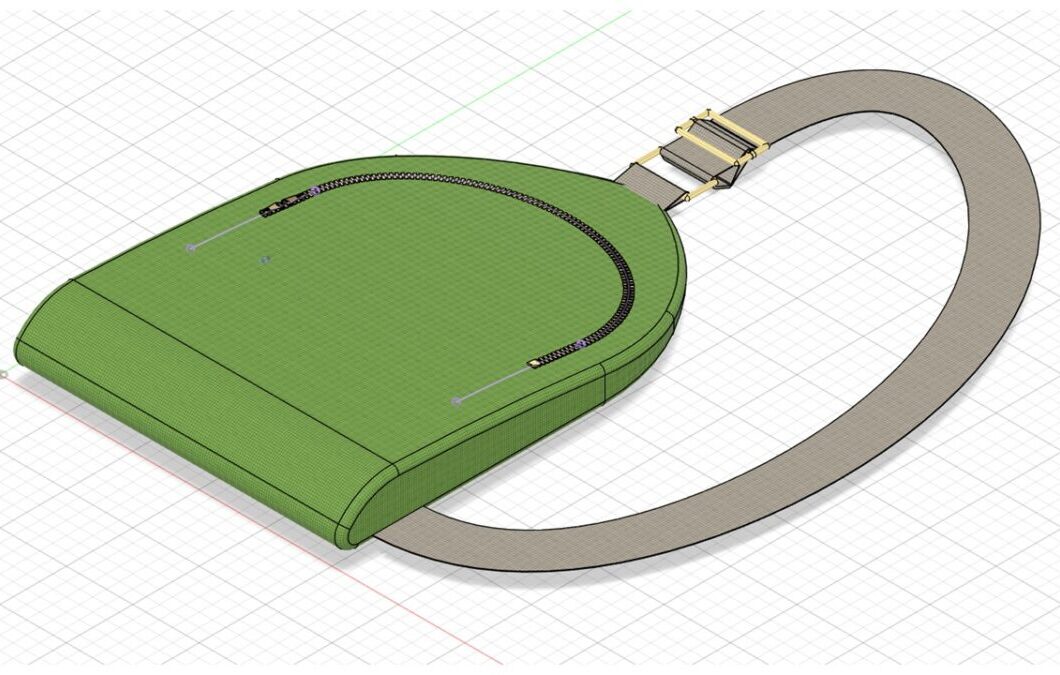 最後は、1年生 八尾 拓樹さんの「わたしのバッグ」です。こちらも曲面が多い難しい形状をバランス良くモデリングしてあります。ファスナーやベルト金具などの細かい部分まで、しっかりと作成してあります。ベルトを金具に通したり、バッグに固定したりする箇所のモデリングも複雑な操作が必要だったと思います。授業内で教えてもらっていない、機能や操作が必要な場面も多くあったでしょう。それらを自分で調べて、学び、成果が出た経験は、今後の他の課題でも役に立つことと思います。ベルトの曲げ方を3次元的に(奥行き方向に曲げる)すれば、もっとリアルに見えますので、ぜひ挑戦してみて欲しいと思います。
最後は、1年生 八尾 拓樹さんの「わたしのバッグ」です。こちらも曲面が多い難しい形状をバランス良くモデリングしてあります。ファスナーやベルト金具などの細かい部分まで、しっかりと作成してあります。ベルトを金具に通したり、バッグに固定したりする箇所のモデリングも複雑な操作が必要だったと思います。授業内で教えてもらっていない、機能や操作が必要な場面も多くあったでしょう。それらを自分で調べて、学び、成果が出た経験は、今後の他の課題でも役に立つことと思います。ベルトの曲げ方を3次元的に(奥行き方向に曲げる)すれば、もっとリアルに見えますので、ぜひ挑戦してみて欲しいと思います。
1年生 八尾さんコメント
制作時間:1日少しずつ作業して、3日か4日くらいかかりました。
コメント:カーブしたファスナーと、ベルト金具部分の形状にこだわりました。
受賞作のみ、解説をしましたが、受賞とはならなかった他の作品もとても素晴らしかったです。「お出かけに持って行くもの」がテーマということで、バッグや眼鏡、スマホ、ポータブルバッテリーなどが多かったのですが、留学生は2名とも「ナイフ」をモデリングしていました。人間本来のお出かけして生きていく力を感じましたし、大自然の中で役に立ちそうな良い形状でした。来年も継続してコンテストを開催していきますので、学生たちの3DCADスキルのさらなる向上に期待しています。
林 道大

I am Michihiro Hayashi, advisor for the Design & Fabrication Club. This year, as part of the summer vacation assignment, students worked on 3D CAD modeling. The theme was “Things to Take on an Outing”. There were more than 30 submissions from 1st and 2nd year students. The submissions covered a wide range of genres—if you took all of them on a trip, it would surely be a fun and convenient excursion! After careful evaluation by the judges, four outstanding entries were selected for awards.
Let’s take a closer look at the award-winning pieces.
 2nd year student Madoka Nakazawa: My Smartphone
2nd year student Madoka Nakazawa: My Smartphone
Although the geometric shape of a smartphone is simple, this model is highly decorated. Using a combination of arcs and straight lines, the student skillfully recreated a cute character. The bead strap is well represented, and even the shining sun—usually difficult to model in CAD—was given a hand-drawn look. The cracked screen detail was an impressive touch.
Comment from Madoka
Production time: Worked a little each day, about a week in total.
Focus points: Paid attention to details like the camera lens area and the character’s facial expression. The cracked screen is definitely the highlight.
 1st year student Taiki Sasaki: My Glasses
1st year student Taiki Sasaki: My Glasses
This model of eyeglasses is extremely realistic—almost like something from an optical shop catalog. Not only the overall shape, but also the rims, bridge, end pieces, nose pads, hinges, and temples were faithfully reproduced. Even the complex curved surfaces were carefully modeled. Wearing these glasses might make you feel smarter—perhaps reflecting the creator’s intention.
Comment from Taiki
Production time: About 6 hours.
Focus points: Closely observed my own glasses, especially the three-dimensional feel of the rims that hold the lenses.

1st year student Reo Sakai: My Lantern
The overall shape is well balanced, and the model includes functional details such as the mechanism for lighting and extinguishing the lantern, the fuel compartment, and the screw-on lid. These were created so their functions could be explained clearly. If the flickering flame inside a dim tent were rendered in CG, it would make a stunning video—possibly even a top entry in a CG contest.
Comment from Reo
Production time: Worked 2–3 hours a day for 2–3 days.
Focus points: Paid attention to texture settings and the screw shape of the lid. The lid could probably be 3D printed and used in real life.
 1st year student Hiroki Yatsuo: My Bag
1st year student Hiroki Yatsuo: My Bag
This piece features many curved surfaces, which are difficult to model, yet they are well balanced. Details such as zippers and metal buckles were carefully crafted. Modeling the parts where the belt passes through the buckle and attaches to the bag required complex operations. There were likely many functions and techniques not taught in class, so the student must have researched and learned independently—a valuable experience for future projects. If the belt were bent three-dimensionally (with depth), the model would look even more realistic, so I encourage trying that next time.
Comment from Hiroki
Production time: Worked a little each day, about 3–4 days in total.
Focus points: Focused on the curved zipper and the shape of the belt buckle.
Although I only introduced the award-winning works, the other submissions were also excellent. Since the theme was “Things to Take on an Outing,” many students modeled bags, glasses, smartphones, and portable batteries. Interestingly, international students chose to model knives, perhaps reflecting humanity’s innate survival instincts and the usefulness of such tools in nature.
I plan to continue this contest next year and look forward to seeing even greater improvements in students’ 3D CAD skills.
Michihiro Hayashi
 みなさん、こんにちは。物理科目を担当している伊藤 周です。今回は、毎年恒例の「STEMフェア2025」についてお話しします。
みなさん、こんにちは。物理科目を担当している伊藤 周です。今回は、毎年恒例の「STEMフェア2025」についてお話しします。
STEMフェアは、国際高専の夏休み課題「Summer STEM Project」の成果を発表する場で、毎年9月下旬に開催されています。簡単に言えば、夏の自由研究の発表会です。テーマは学生が自由に決めますが、今年は特に1年生のアイデアがとてもユニークで、これまでにないテーマがたくさんありました。国際高専が始まって8年、STEMフェアも今回で8回目(2年生の分も合わせると15回目)になりますが、毎年新しい発想に出会えるのは本当に面白いですね。
さらに、今年は実験や製作にすごく時間と労力をかけている学生が多かったのも印象的でした。たとえば、魚のプラスチック汚染を調べるために何十匹も釣って内臓を確認したり、身長への影響を調べるために約3,000回ジャンプしたり、アニメーションを作るために何十枚ものカットを描いたり、海洋ゴミを調べるために地元の半島を一周したり、炎天下を7km歩いたり…。
発表自体はポスター1枚と10分ほどの説明だけですが、その裏にある努力や時間を想像すると、本当に感動します。
個人的には、こういう「とにかくやってみた!」というプロジェクトが大好きです。たとえ科学的に完璧じゃなくても、その熱意を評価したくなります。ただ、発表としてはやっぱり図や表を使って、そこから考察をまとめることも大切なので、その点は学生たちに伝えました。
STEMフェアは、学生の頑張りと先生方の協力で、今や白山麓キャンパスの名物イベントになりました。まだ1・2年生なので高度な研究とは言えませんが、学生たちの自由な発想や興味を形にしたプロジェクトを見るのは本当に楽しいです。これからも、このイベントを続けていきたいです。
伊藤 周
 Hello everyone, I’m Meguru Ito, a physics teacher. Today, I’d like to talk about our annual STEM Fair, in this case STEM Fair 2025.
Hello everyone, I’m Meguru Ito, a physics teacher. Today, I’d like to talk about our annual STEM Fair, in this case STEM Fair 2025.
The STEM Fair is a venue for presenting the outcomes of the ICT’s summer assignment, the Summer STEM Project, and it is held every year in late September. Simply put, it’s a showcase for summer independent research. Students choose their own themes, but this year, the ideas from 1st year students were especially unique, with many topics we’ve never seen before. Since ICT was founded eight years ago, this is the eighth STEM Fair (or the fifteenth if we include the 2nd year presentations), and it’s always exciting to encounter fresh ideas every year.
What stood out this time was how much time and effort many students invested in ttheir experiments and production. For example, some caught dozens of fish to examine their organs for plastic contamination, others jumped about 3,000 times to study the effect on height, created animations by drawing dozens of frames, circled a local peninsula to investigate marine debris, or walked 7 km under the blazing sun.
Although each presentation consists of just one poster and about ten minutes of explanation, imagining the effort and time behind them is truly moving.
Personally, I love these “just give it a try!” projects. Even if they’re not scientifically perfect, I want to recognize that enthusiasm. Of course, for a proper presentation, using charts and tables and drawing conclusions from them is also important, so I made sure to convey that to the students.
Thanks to the students’ hard work and the teachers’ support, the STEM Fair has become a signature event at the Hakusanroku Campus. While 1st and 2nd year students’ projects aren’t advanced research yet, seeing their ideas and interests take shape is incredibly enjoyable. I hope we can keep this event going for years to come.
Meguru Ito
プロジェクト1:ネームタグ制作
こんにちは。白山麓キャンパスで1年生のエンジニアリングデザインを担当しているブランドン・ウォルファースです。国際高専のエンジニアリングデザインの授業では、学生たちが多様なプロジェクトに取り組みますが、デザインプロセスへの「導入」として、最初のプロジェクト「個性を表現するネームタグの制作」に挑戦しました。
このプロジェクトにはいくつかの条件がありました。ネームタグは着用可能であること、指定されたサイズ内に収まること、白山麓キャンパスにある3Dプリンターやレーザーカッターを使用して制作すること、そして制作者本人の特徴を視覚的に表現することが求められました。
学生たちはアイデアの発想から始まり、プロトタイピング(試作品作り)を通じて、特徴と機能の関係性について学びました。プロジェクトの締めくくりには、英語でのプレゼンテーションを行い、クラスメートに自作のネームタグを紹介しました。
エンジニアリングデザインの魅力は、テストやクイズとは異なり、問題解決に「唯一の正解」が存在しない点です。学生たちがそれぞれの方法で課題に取り組む様子は非常に興味深く、多くの学生が自身の趣味や好きなメディアをテーマにすることで、作品に個性を反映させていました。これは学生たちにとって初めてのデザイン体験であり、今後の成長が非常に楽しみです。
プロジェクト2:チームによる課題解決
前学期の後半には、1年生はチームプロジェクトにも取り組みました。このプロジェクトの目的は、学生が日常生活を観察し、「毎日使っている中で最も不便なもの」を特定し、それに対する個人的な課題を解決する方法を考案することです。
この活動で特に興味深いのは、学生たちが日常の中でどのような不便さを認識し、それにどう向き合うかという点です。各グループが取り組んだ課題は多様でしたが、共通して求められたのは、「対象物の使用方法の理解」「目的の機能を果たすために必要な特徴の把握」、そして「人間中心の設計の重要性」でした。
以下に、各グループの取り組みをご紹介します。
1. Ukusta(ウクスタ)
このグループは、白山麓キャンパスのリビングコモンズにあるウクレレのための新しいスタンドの設計に挑戦しました。楽器の安定性を高めるとともに、空間の美観を向上させることを目指しました。
2. Nosepads(ノーズパッド)
このグループは、さまざまな眼鏡やサングラスに対応できる調整可能なノーズパッドの開発に取り組みました。鼻の形状に合わせてフィットするよう設計されており、試作品はサイズの関係上、拡大モデルでの提示となりました。
3. The Tangle Terminator(タングル・ターミネーター)
このグループは、ノートパソコンの充電ケーブルがバックパック内で絡まりやすいという問題に着目し、収納性を向上させるための整理ツールを考案しました。持ち運びの利便性を重視した設計です。
4. Magnamewash(マグネームウォッシュ)
このグループは、白山麓キャンパスの寮にあるランドリー設備の利用状況を整理する方法を模索しました。誰がどの機械を使用しているかを簡単に把握できる、設置・使用が容易で情報伝達が明確な仕組みを目指しました。
5. Sortaro(ソルタロウ)
このグループは、ごみの分別が複雑で時間がかかるという問題に取り組みました。日本の分別システムに慣れていない人でも使いやすく、適切に分別できる一体型のごみ箱の設計を目指しました。
6. Shampoo Guardian Project(シャンプー・ガーディアン・プロジェクト)
このグループは、寮のシャワー室における収納スペースの不足に着目しました。シャワー中に使用するボトル類を簡単に持ち運び、アクセスできる収納ツールの開発に取り組みました。
後学期に学生たちがどのようなプロジェクトに挑戦するのか、今から非常に楽しみにしています。
ブランドン・ウォルファース

Project 1:Creating Name Tags
Hello everyone, this is Brandon Wohlfarth, one of the Engineering Design teachers for the 1st year students. Within our Engineering Design course here at ICT, students get the chance to work on a wide range of projects, but to help “introduce” the students to the design process, their first project was to create individualized nametags.
There were some criteria that the students needed to follow during the project: their nametag needed to be able to be worn, it needed to fit within a certain volume, it needed to be made using the 3D printers and/or laser cutters that we have here at Hakusanroku Campus, and it needed to visually show important characteristics about the designer.
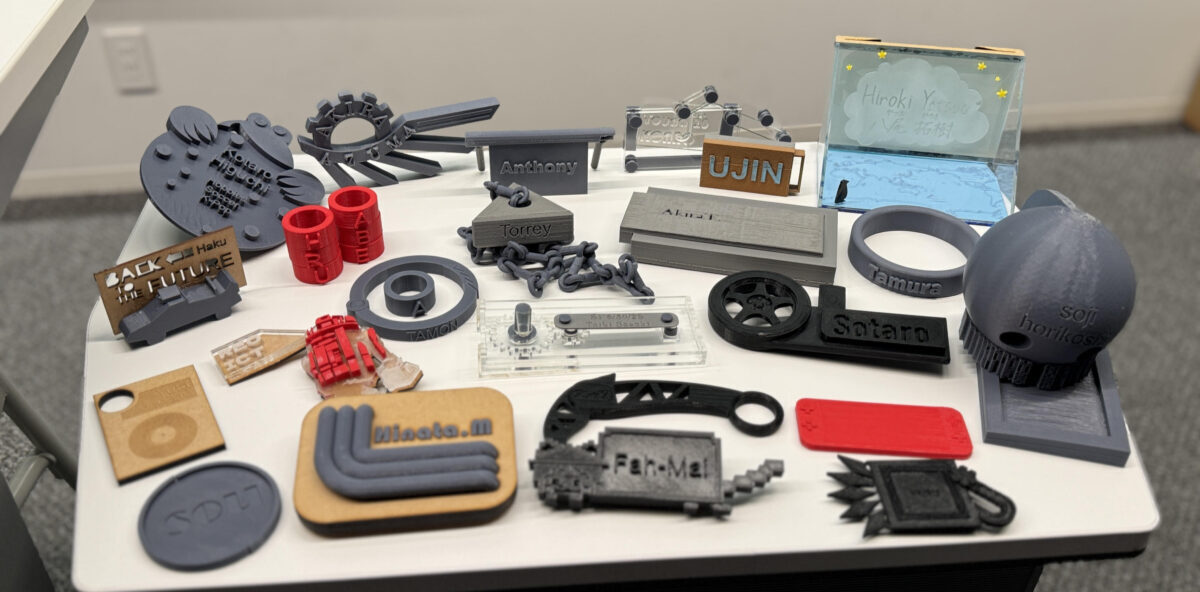 During this project students walked through how to come up with ideas, practiced prototyping, and learned about the connections between features and functions. This project culminated in a presentation where the students were able to “introduce” their nametags to their classmates, and practice their English-speaking skills.
During this project students walked through how to come up with ideas, practiced prototyping, and learned about the connections between features and functions. This project culminated in a presentation where the students were able to “introduce” their nametags to their classmates, and practice their English-speaking skills.
What I enjoy the most about Engineering Design is that, unlike tests and quizzes, there isn’t just one right answer to how to solve the problem. It was very interesting to see how the students decided to approach the challenge ahead of them. Many students focused on creating something that helped introduce their hobbies, or maybe a certain source of media that they enjoyed, allowing them to add parts of their personality into their final creation. This is just the first design experience for the students, so I am looking forward to where they go from here.
Project 2:Solving Problems through Teamwork
Within the first semester the first-year students also worked on a team project in Engineering Design IA. The goal of this project is for students to observe the world around them and identify the “Worst thing that they use everyday” and try to find a solution their individual pain points regarding the topic selected. An aspect of this project that I enjoy seeing is how students perceive and approach different challenges or inconveniences that they experience in their daily life. Each group tackled a very different problem, but they still needed to understand how an object is used, what are important features needed to complete a desired function, and a little about how people are an important part in designing a new product. We always get some interesting projects when we do this activity, so I am excited to share them all with you.
1. Ukusta
This group decided to take on the challenge of designing a new stand for the ukuleles found in the Living Commons at the Hakusanroku Campus. They wanted to make something that would stabilize the instrument while also helping to improve the visual aesthetics of the space.
2. Nosepads
This group decided to devise an adjustable attachment that could fit with various glasses or sunglasses, in order to help match the shape and contour of different noses. Due to the size that this type of attachment would need to be, for demonstration purposes only, their prototype was an enlarged version of their design.
3. The Tangle Terminator
This group decided to envision a way to help organize their laptop charging cables to improve upon its ability to be stored inside of a backpack, as most students do. They found that inside of the backpack, the cables tended to become tangled easily, which lead them to address this issue within the scope of portability.
4. Magnamewash
This group wanted to find a way to help organize the use of the laundry facilities within the Hakusanroku Campus dormitories. They wanted to help solve the issues of not knowing who is using what machine in an easy to install, easy to use way that would transfer information quickly and clearly.
5. Sortaro
This group found that sorting trash can be a difficult and time-consuming activity, and as someone who even after years of living in Japan still has challenges understanding this system I can relate. They wanted to make something that would still properly sort various types of garbage, but be in one easy to use location.
6. Shampoo Guardian Project
This group wanted to address the lack of shelving space within the showers at the Hakusanroku Campus dormitory. They wanted something that could be used within the shower stalls on campus, that was easy to carry and to access the various bottles that they wanted to use while showering.
I am looking forward to what they do in the second semester!
Brandon Wohlfarth

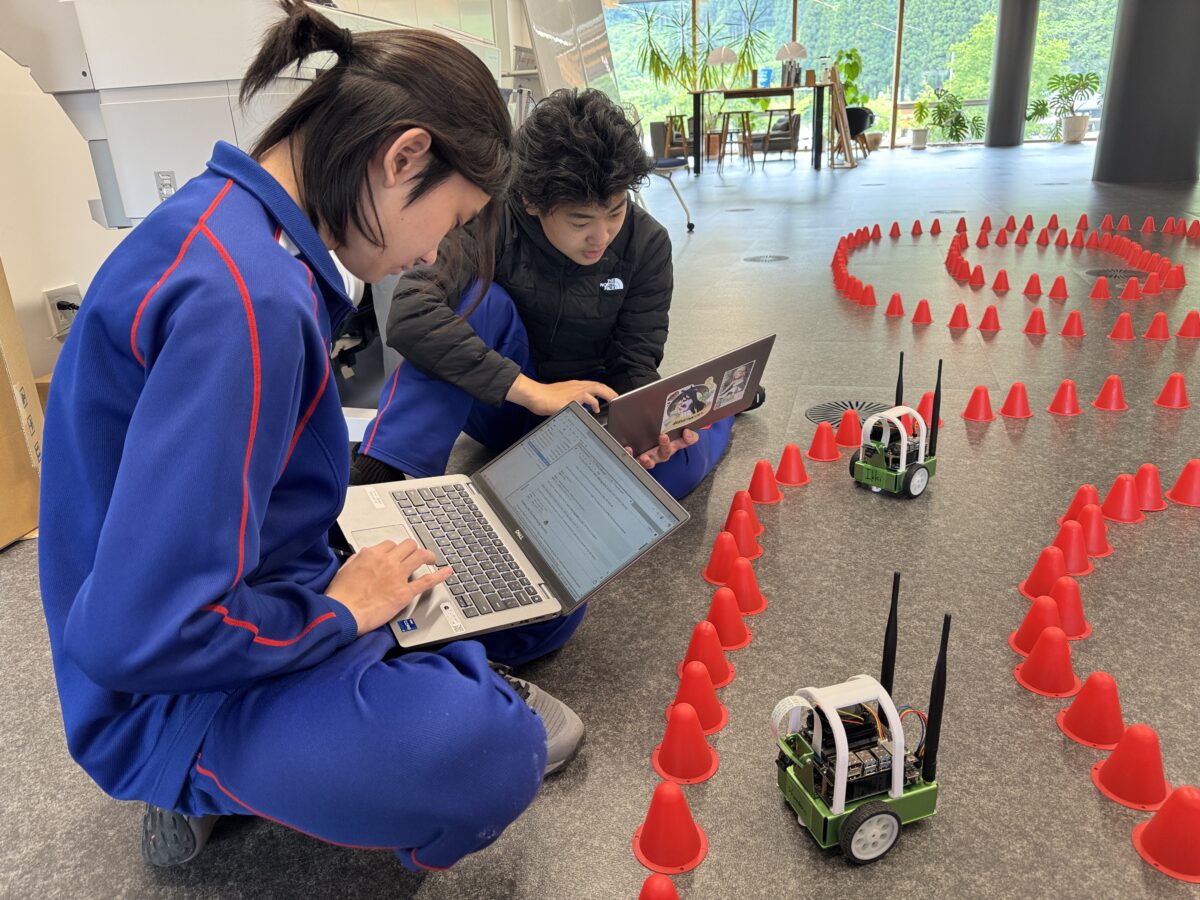 こんにちは。ハヤト・オガワです。白山麓キャンパスで、エンジニアリングデザインⅡA(2年生)とコンピュータスキルズⅡA(2年生)の授業を教えています。AIや未来をテーマにした映画が好きな私にとって、1968年公開の映画「2001年宇宙の旅」(原題:2001: A Space Odyssey)のような作品では、テクノロジーがどのように想像され、そして時に脅威として描かれている様子を見ることはとても興味深いです。AIをただ恐れるのではなく、その仕組みを理解し、責任を持って制御する方法を一緒に学んでみませんか。
こんにちは。ハヤト・オガワです。白山麓キャンパスで、エンジニアリングデザインⅡA(2年生)とコンピュータスキルズⅡA(2年生)の授業を教えています。AIや未来をテーマにした映画が好きな私にとって、1968年公開の映画「2001年宇宙の旅」(原題:2001: A Space Odyssey)のような作品では、テクノロジーがどのように想像され、そして時に脅威として描かれている様子を見ることはとても興味深いです。AIをただ恐れるのではなく、その仕組みを理解し、責任を持って制御する方法を一緒に学んでみませんか。
JetBotプロジェクトが2年生のコンピュータースキルズの授業に導入されてから数年が経ちましたが、この実践的な活動はICTのカリキュラムの重要な一部となっています。時間が経つ中で、ハードウェアの故障や操作中の落下事故により、いくつかのJetBot が使えなくなることもありましたが、このプロジェクトは今でもロボティクスと人工知能の学びとして貴重な体験となっています。
実践を通じて学ぶ:Pythonから衝突回避まで
NVIDIA Jetson Nanoマイクロコンピューターを基盤とするJetBotプラットフォームは、学生がAIを活用したロボティクスの実践的な学びの入門に適しています。学生はまず、ロボットを制御するための基本的なPythonプログラミングを学び、次に画像収集を通じてデータセットを作成し、最終的に衝突回避モデルの開発に取り組みます。搭載されたカメラを活用しながら、各学生は自分のJetBotを障害物コースで安全に走行させるための訓練を行い、理論的な知識と実践的なスキルの両方を応用して、データセットやモデルの品質が動作にどのような影響を与えるかを理解していきます。
この活動は、長年にわたり学生たちのAIやロボティクスに対する理解を深めるだけでなく、高品質なデータの重要性、慎重に問題を解決する力、そしてシステムの信頼性の大切さについても学ぶきっかけになっています。こうしたスキルは、将来エンジニアリングやテクノロジーの分野で活躍するうえで不可欠なものです。AI技術が主流になりつつある今、将来的に、自動運転車などの分野で働く学生も出てくるかもしれません。そうした分野では、精度やデータの完全性が実際の社会に直接影響を与えるのです。
挑戦を乗り越え、成長へとつなげる
JetBotの公式ドキュメントやプログラミング教材は大学レベルの英語で書かれているため、それを理解するために英語力が必要なことが課題となっています。しかし、教員とラーニングメンターによる継続的なサポートと指導により、学生たちは言語の壁を乗り越えながら、技術・学術的なスキルの両方を身につけています。
一部のJetBotsは修理が必要とある場面もありましたが、どの出来事も貴重な学びの機会となり、実際のハードウェアを扱うことの現場を体験することにつながりました。このJetBotプロジェクトは、プログラミング、人工知能、そして実践的なトラブル対応力を融合させた、実践的かつ学際的な教育プログラムとして、進化を続けています。ICTは、学生たちが現代の技術社会で活躍できるよう、確かな力を育む取り組みをこれからも続けていきます。
ハヤト・オガワ


Hello, this is Hayato Ogawa (Associate Professor) at International College of Technology. I teach Engineering Design 2 and Computer Skills 2 classes at Hakusanroku campus. As someone who enjoys watching science fiction movies about AI and the future—like 2001: A Space Odyssey—I’m always fascinated by how technology is imagined and sometimes feared. Instead of fearing AI, I believe it's important to understand how it works and how we can control it responsibly.
Several years have passed since the introduction of the JetBot project in the Computer Skills 2 class, and this hands-on activity remains an integral part of the curriculum at ICT. Despite the passage of time and the occasional loss of a few JetBots due to hardware failures or accidental falls during operation, the project continues to provide students with a valuable introduction and experience in both robotics and artificial intelligence.
Learning Through Doing: From Python to Collision Avoidance
The JetBot platform, built on the NVIDIA Jetson Nano microcomputer, offers students a practical introduction to AI-based robotics. Students begin by learning basic Python programming to control their robots, followed by creating datasets through image collection, and ultimately developing collision avoidance models. By using the onboard camera, each student trains their JetBot to navigate safely through obstacle courses, applying both theoretical knowledge and practical skills to understand how the quality of their dataset and models affects operation.
Over the years, this activity has not only strengthened students’ understanding of AI and robotics. It has also emphasized the importance of high-quality data, careful problem-solving, and system reliability, cultivating essential skills for future careers in engineering and technology. As I noted when the program was first introduced, AI technology is becoming mainstream; some students may eventually work in fields such as autonomous vehicles, where accuracy and data integrity have direct real-world implications.
Overcoming Challenges and Fostering Growth
One ongoing challenge remains the English proficiency required to navigate the official JetBot documentation and programming materials, which are written at a university level. However, with the consistent support and guidance of faculty members and learning mentors, students can overcome these language barriers while developing both technical and academic skills in the process.
While a few JetBots have been repaired along the way, each incident has provided additional learning opportunities, reinforcing the realities of working with physical hardware. The JetBot project continues to serve as a meaningful, multidisciplinary learning experience that combines programming, artificial intelligence, and practical troubleshooting. It remains a strong example of ICT’s commitment to preparing students for the demands of the modern technological landscape.
Hayato Ogawa
 こんにちは。白山麓高専事務室の間加田 侑里です。今回は、1年生の笹木 大暉さんがAutodesk Fusionを用いて制作した作品を紹介します。
こんにちは。白山麓高専事務室の間加田 侑里です。今回は、1年生の笹木 大暉さんがAutodesk Fusionを用いて制作した作品を紹介します。
「コンピュータスキルズⅠA(1年生)」の授業では、1年生が入学した直後からAutodesk Fusionを活用した3Dモデリング制作に取り組みます。この授業では、エンジニアにとって必要なコンピュータの基本的なスキルを学習します。笹木さんは、授業で学んだことをもとに、2ヶ月間かけて「V8エンジン」の3Dモデル制作に挑戦しました!その様子を動画で紹介します。どうぞご覧ください!
間加田 侑里
 Hello, this is Yuri Makada from the Hakusanroku Office. This time, I would like to introduce a project created by 1st year student Taiki Sasaki using Autodesk Fusion.
Hello, this is Yuri Makada from the Hakusanroku Office. This time, I would like to introduce a project created by 1st year student Taiki Sasaki using Autodesk Fusion.
In the Computer Skills IA course for 1st year students, students begin working with Autodesk Fusion to create 3D models right after entering ICT. In this class, students learn the fundamental computer skills necessary for engineers. Taiki Sasaki, a 1st year student, applied what he learned in class and spent two months creating a 3D model of a V8 engine! I've put together a video showcasing his work—please watch!
Yuri Makada









